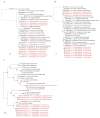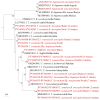High Diversity and Low Coinfections of Pathogens in Ticks from Ruminants in Pakistan
- PMID: 40572164
- PMCID: PMC12195261
- DOI: 10.3390/microorganisms13061276
High Diversity and Low Coinfections of Pathogens in Ticks from Ruminants in Pakistan
Abstract
Emerging tick-borne infections pose growing public health threats, causing global disease burdens and economic losses. In this study, tick-borne pathogens were detected in ticks collected from ruminants in 19 sites of Khyber Pakhtunkhwa Province, Pakistan, between 2023 and 2024. A total of 989 ticks, belonging to five species, i.e., Hyalomma marginatum, Rhipicephalus microplus, Rhipicephalus sanguineus, Rhipicephalus haemaphysaloides, and Haemaphysalis bispinosa, were tested by specific PCR followed by Sanger sequencing. In total, fourteen pathogens including two Anaplasma species, three Ehrlichia species, three Rickettsia species, one Babesia species, and five Theileria species were identified, with an overall infection rate of 20.2% (95% CI: 17.7-22.7%). Phylogenetic analyses revealed two undefined Ehrlichia species: Candidatus Ehrlichia hyalommae was exclusively detected in Hy. marginatum ticks, while Candidatus Ehrlichia rhipicephalis was only found in R. microplus. Additionally, an undefined Rickettsia, provisionally named Candidatus Rickettsia pakistanensis, was identified, which is phylogenetically close to R. sibirica in North Asia and R. africae in Africa, suggesting its potential pathogenicity to humans. Although coinfections of two pathogens were observed, the coinfection rates were quite low. The findings revealed a significant diversity of tick-borne pathogens in Pakistani ticks, which may pose risks to livestock and humans.
Keywords: Anaplasma; Babesia; Ehrlichia; Pakistan; Rickettsia; Theileria; high diversity; phylogenetic analysis.
Conflict of interest statement
The authors declare no conflicts of interest.
Figures





Similar articles
-
Prevalence of tick-borne pathogens in Rhipicephalus species infesting domestic animals in Africa: A systematic review and meta-analysis.Acta Trop. 2023 Oct;246:106994. doi: 10.1016/j.actatropica.2023.106994. Epub 2023 Jul 27. Acta Trop. 2023. PMID: 37516420
-
Molecular detection and characterization of spotted fever group Rickettsia and Anaplasma in ticks from Pakistan.Parasitology. 2025 May;152(6):632-640. doi: 10.1017/S0031182025100358. Parasitology. 2025. PMID: 40509998 Free PMC article.
-
Ticks and tick-borne pathogens in selected abattoirs and a slaughter slab in Kumasi, Ghana.Vet Med Sci. 2024 Sep;10(5):e70030. doi: 10.1002/vms3.70030. Vet Med Sci. 2024. PMID: 39285746 Free PMC article.
-
Tick-borne pathogens in camels: A systematic review and meta-analysis of the prevalence in dromedaries.Ticks Tick Borne Dis. 2024 Jan;15(1):102268. doi: 10.1016/j.ttbdis.2023.102268. Epub 2023 Sep 26. Ticks Tick Borne Dis. 2024. PMID: 37769585
-
Ticks and tick-borne bacterial pathogens found on hard ticks (Acari: Ixodidae) on cattle in the Central River region of The Gambia.Med Vet Entomol. 2025 Aug 16. doi: 10.1111/mve.70004. Online ahead of print. Med Vet Entomol. 2025. PMID: 40818048
References
-
- Paules C.I., Marston H.D., Bloom M.E., Fauci A.S. Tickborne diseases—Confronting a growing threat. N. Engl. J. Med. 2018;379:701–703. - PubMed
-
- Rahman A., Kashif M., Nasir A., Idress A., Jamil M., Qadir Z.A., Qasim M., Khan I., Aziz H., Qazi I., et al. A review of tick and tick control strategies in Pakistan. Pak. J. Med. Health Sci. 2022;16:652–655. doi: 10.53350/pjmhs22161652. - DOI
Grants and funding
LinkOut - more resources
Full Text Sources

